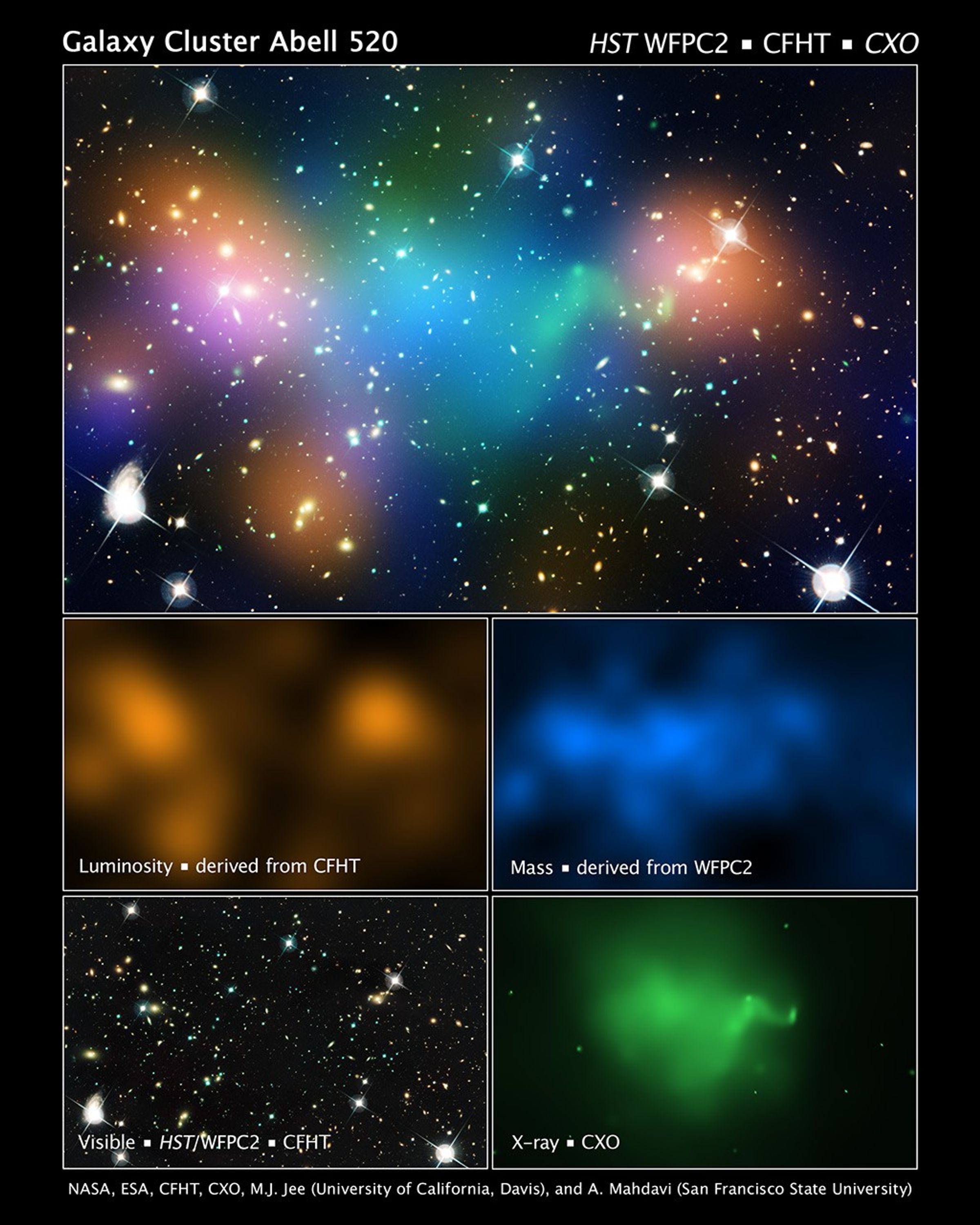1 min read
Galaxy Cluster Abell 520 (with CFHT, HST, CFHT/HST, and CXO Overlays)

This composite image shows the distribution of dark matter, galaxies, and hot gas in the core of the merging galaxy cluster Abell 520, formed from a violent collision of massive galaxy clusters.
The natural-color image of the galaxies was taken with NASA's Hubble Space Telescope and with the Canada-France-Hawaii Telescope in Hawaii. Superimposed on the image are "false-colored" maps showing the concentration of starlight, hot gas, and dark matter. Starlight from galaxies, derived from observations by the Canada-France-Hawaii Telescope, is colored orange. The green-tinted regions show hot gas, as detected by NASA's Chandra X-ray Observatory. The gas is evidence that a collision took place. The blue-colored areas pinpoint the location of most of the mass in the cluster, which is dominated by dark matter. Dark matter is an invisible substance that makes up most of the universe's mass. The dark-matter map was derived from the Hubble Wide Field Planetary Camera 2 observations by detecting how light from distant objects is distorted by the cluster of galaxies, an effect called gravitational lensing.
The blend of blue and green in the center of the image reveals that a clump of dark matter resides near most of the hot gas, where very few galaxies are found. This finding confirms previous observations of a dark-matter core in the cluster. The result could present a challenge to basic theories of dark matter, which predict that galaxies should be anchored to dark matter, even during the shock of a collision.
Abell 520 resides 2.4 billion light-years away.
About the Object
- R.A. PositionR.A. PositionRight ascension – analogous to longitude – is one component of an object's position.04h 54m 18.98s
- Dec. PositionDec. PositionDeclination – analogous to latitude – is one component of an object's position.02° 56' 48.8"
- ConstellationConstellationOne of 88 recognized regions of the celestial sphere in which the object appears.Orion
- DistanceDistanceThe physical distance from Earth to the astronomical object. Distances within our solar system are usually measured in Astronomical Units (AU). Distances between stars are usually measured in light-years. Interstellar distances can also be measured in parsecs.2.4 billion light-years (740 million parsecs)
About the Data
- Data DescriptionData DescriptionProposal: A description of the observations, their scientific justification, and the links to the data available in the science archive.
Science Team: The astronomers who planned the observations and analyzed the data. "PI" refers to the Principal Investigator.The image was created from Hubble data from proposal 11221: J. Dalcanton (University of Washington, Seattle), A. Mahdavi (San Francisco State University), H. Hoekstra (Leiden Observatory), and A. Babul (University of Victoria, BC). The science paper is led by M.J. Jee (University of California, Davis). - InstrumentInstrumentThe science instrument used to produce the data.HST>WFPC2, CFHT, and Chandra
- Exposure DatesExposure DatesThe date(s) that the telescope made its observations and the total exposure time.August 19-22, 2008, Exposure Time: 11 hours
- FiltersFiltersThe camera filters that were used in the science observations.CFHT (B), CFHT (V), HST/WFPC2 F814W (I), and CXO X-ray
- Object NameObject NameA name or catalog number that astronomers use to identify an astronomical object.Abell 520
- Object DescriptionObject DescriptionThe type of astronomical object.Merging Galaxy Cluster
- Release DateMarch 2, 2012
- Science ReleaseDark Matter Core Defies Explanation in Hubble Image
- Credit

This image is a composite of separate exposures acquired by the HST/WFPC2 instrument, the Canada-France-Hawaii Telescope (CFHT), and the Chandra X-ray Observatory. Several filters were used to sample various wavelength and energy ranges. The color results from assigning different hues (colors) to each monochromatic (grayscale) image associated with an individual filter. In this case, the assigned colors are: White (visible): CFHT (B) + CFHT (V) + HST/WFPC2 F814W (I) Red (luminosity): CFHT Blue: HST/WFPC2 F814W (I) Green: CXO X-ray

Related Images & Videos

Merging Galaxy Cluster Abell 520
This composite image shows the distribution of dark matter, galaxies, and hot gas in the core of the merging galaxy cluster Abell 520, formed from a violent collision of massive galaxy clusters. The natural-color image of the galaxies was taken with NASA's Hubble Space Telescope...

Galaxy Cluster Abell 520 (HST-CFHT-CXO Composite)
This composite image shows the distribution of dark matter, galaxies, and hot gas in the core of the merging galaxy cluster Abell 520, formed from a violent collision of massive galaxy clusters. The natural-color image of the galaxies was taken with NASA's Hubble Space Telescope...

Galaxy Cluster Abell 520's Hot Gas (Chandra)
This image shows regions of hot gas at the core of merging galaxy cluster Abell 520, detected by NASA's Chandra X-ray Observatory. The gas is evidence that a collision between massive galaxy clusters took place. Abell 520 resides 2.4 billion light-years away.

Galaxy Cluster Abell 520's Mass (HST WFPC2)
This image shows the location of most of the mass in merging galaxy cluster Abell 520's core, which is dominated by dark matter. Dark matter is an invisible substance that makes up most of the universe's mass. The dark-matter map was derived from Hubble Wide Field Planetary...
Share
Details
Claire Andreoli
NASA’s Goddard Space Flight Center
Greenbelt, Maryland
claire.andreoli@nasa.gov































